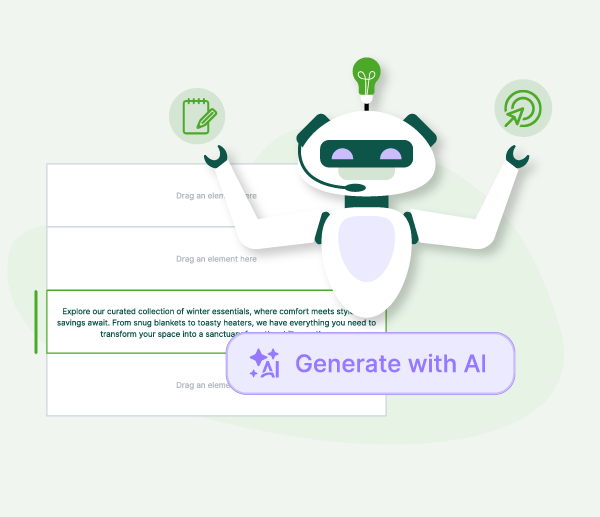The ABCs of Email Marketing
A
A/B test
Refers to an email test when two different versions of a single email are created and sent to two groups on your contacts list.
Above the fold
The part of an email message or web page that is visible without scrolling. Material in this area is considered more valuable because it's what everyone sees first.
Anti-Spam Laws
Anti-spam laws are laws around unsolicited emails that protect people from receiving unwanted spam emails. It’s important to note that anti-spam laws are different depending on the state and country you live in.
Authentication
An automated process that verifies an email sender's identity.
B
Blacklist
A list that blocks IP addresses, impeding email deliverability and affecting sender reputation.
Bounce rate
The rate at which your emails are not delivered is divided by the number of emails sent.
Bulk Mail
Large scale email marketing sends in which the same content goes to a large group of people.
C
Call-to-action
In an email, this is the link or copy that tells the recipient what action to take.
CAN-SPAM
Popular name for the U.S. law regulating commercial email Controlling the Assault of Non-Solicited Pornography and Marketing Act of 2003)
Clicks
Clicks simply measure the total number of times any link in the email was clicked.
Click-Through Rate (CTR)
Measures how many people who received your email also clicked on a hyperlink, CTA, or image in that email. It’s calculated by dividing total number of clicks by total number of delivered emails.
Click-to-Open Rate (CTOR)
The click-to-open rate (CTOR) compares the number of unique clicks to unique opens. This number measures how many people who opened your email also interacted with it’s content.
Conversion
When a recipient performs an action that’s valuable to the business. This is one measure of your email campaign’s success.
D
Deliverability
Deliverability is the ability to deliver emails to inboxes.
Double Opt-In
A double opt-in is an email marketing sign up method that includes an additional confirmation step for the subscriber. They will be sent an email which includes a link to click and confirm the subscription. Only after the confirmation is completed will they be added to the marketing list.
Drip Campaign
A drip campaign is a series of automated, time-based emails. They’re emails that you send out over a specified amount of time.
E
Email Client
An email client is an application that enables users to manage their inbox by sending, receiving, and organizing messages directly from a desktop or mobile device.
Email Marketing Benchmarks
Email marketing benchmarks are metrics a business or organisation uses to compare how their emails are doing against others in their industry. Common benchmarks include open rate, click-through rate, bounces, and unsubscribes.
Email Service Provider (ESP)
Email service providers are platforms that enable marketers to grow their list of subscribers, and build and send email marketing campaigns. Like APSIS One!
Email Template
An email template is a pre-designed framework that gives marketers a starting point to create their email. Templates are used when marketers don’t want to start from scratch.
H
Hard Bounce
A hard bounce is an email that has failed to deliver for permanent reasons, such as invalid recipient address because the domain name is incorrect, isn’t real, or the recipient is unknown. Hard bounces are more damaging to the sender reputation than soft or technical bounces.
J
Junk email
Also called spam, it sometimes includes phishing links from sites that host malware and viruses. It is sent in bulk, and sometimes appears as unsolicited commercial emails.
L
List Hygiene
List hygiene is a form of audience management. Marketers should periodically review their contacts to remove bounced addresses, inactive subscribers, and re-verify permission from subscribers.
M
Marketing Automation
Marketing automation is when software sends automated campaigns based on pre-set triggers.
Multivariate Testing
Unlike A/B testing, multivariate testing evaluates several elements in an email to find the best possible combination.
O
Open rate
The open rate measures how many people opened an email divided by delivered emails. This number does not include bounced emails.
Opt-Out
Or unsubscribe is when a contact requests to be removed from a list, or all lists owned by the sender.
P
Permission Marketing
Permission marketing is a term that refers to consumers opting in and providing consent to receive marketing offers and emails from a brand over time.
Personalisation
Personalisation is when marketers use subscriber data within their communications to make the content feel tailor-made for each individual.
Plain Text Email
A plain text email contains only text—no images, graphics, and no formatting.
Preheader
The preheader is usually a sentence-long text that follows a subject line. It shows up in the inbox to give readers an idea of what the email is about before they open it.
S
Segmentation
Segmentation is the division of subscribers into groups based on conditions such as demographics, interests, behaviours, and more. Segmentation is also used as a way to personalise content and deliver relevant email marketing messages.
Soft Bounce
Soft bounce is an email that has failed to deliver due to a less permanent issue, like a full recipient inbox. Usually, ESPs will attempt resends over the course of a few days.
Spam email
Also called junk, it sometimes includes phishing links from sites that host malware and viruses. It is sent in bulk, and sometimes appears as unsolicited commercial emails.
Subject Line
A subject line that briefly describes the topic of the email. It is a short line of text people see when they receive your email and can often determine whether an email is opened or not.
T
Technical Bounce
A technical bounce is considered a type of soft bounce. Technical bounces occur when the email server rejects the email due to technical errors, like network errors or authentication errors. ESPs also attempt resends for technical bounces.
Transactional Email
Transactional emails are a type of email following-up on an agreed-upon transaction between the sender and the recipient. Common transactional email examples are account creation emails, password resets, order receipts, and more emails that are not for marketing purposes.
U
Unsubscribe
Unsubscribe is when a contact chooses to opt-out of receiving any more emails.
W
Webmail
Webmail is an email service that can be accessed using a standard web browser. The main advantage over the use of an email client is the ability to send and receive email anywhere from a web browser, however users will need to be connected to the Internet to use it.
Whitelist
The whitelist is a list of “safe” email addresses of which a spam filter always allows delivery. A user has to manually add the sender’s address to a list of safe senders on their email client to be whitelisted, and it’s a different process for each email client.






